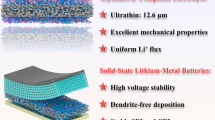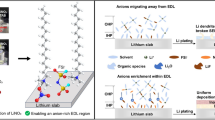Abstract
The polymer-ceramic composite electrolyte is considered as one of promising electrolytes for solid-state battery. However, in previous research, ceramic particles are usually dispersed in polymer matrix and could not form continuous Li+ conductive channels. The agglomeration of ceramic particles could also lead to low ionic conductivity and poor interfacial electrode/electrolyte contact. In this paper, self-supported porous Li6.4La3Zr1.4Ta0.6O12 (LLZTO) electrolyte is synthesized by gelcasting process, which possesses three-dimensional (3D) interconnected pore channels and relatively high strength. The 1,3-dioxolane (DOL) could penetrate into the porous LLZTO framework for its excellent fluidity. The subsequent in situ polymerization process by thermal treatment could completely fill the internal pores and improve the interfacial contact with electrode. The resulting 3D composite electrolyte with dual continuous Li+ transport channels in ceramic and polymer components exhibits high ionic conductivity of 2.8 × 10–4 S·cm−1 at room temperature and low Li/electrolyte interfacial resistance of 94 Ω·cm2 at 40 °C. The corresponding Li/Li symmetric cell delivers stable voltage profiles for over 600 h under 0.1 and 0.2 mA·cm−2. The solid-state Li/LiFePO4 battery shows superior rate and cycling performance under 0.1C and 0.2C. This work guides the preparation of composite electrolyte with dual continuous Li+ conductive paths as well as high ceramic ratio and interface modification strategy for solid-state Li metal battery.
Graphical abstract

摘要
聚合物-陶瓷复合电解质被认为是最有前途的固态电池电解质之一, 然而在以往的复合电解质研究中, 陶瓷颗粒通常分散在聚合物基体中, 不能形成连续的锂离子导电通道, 陶瓷颗粒的团聚也可能导致离子电导率低和电极/电解质界面接触不良。本文采用凝胶注模工艺制备了自支撑的多孔Li6.4La3Zr1.4Ta0.6O12电解质, 具有三维互连的孔道结构和较高的强度。1,3-二氧戊环 (DOL)由于具有优异的流动性, 可以轻易地渗透进多孔LLZTO的孔洞内, 随后通过热处理诱发原位聚合过程, 可完全填充内部孔隙并改善与电极的界面接触。制得的三维复合电解质在陶瓷和聚合物电解质组分中具有双连续的锂离子传输通道, 在室温下表现出3.5 × 10−4 S cm−1 的高离子电导率, 在40 °C下表现出94 Ω cm2的锂负极/电解质界面电阻。对应的锂锂对称电池在0.1和0.2 mA cm−2的电流密度下可稳定循环超过600 h, 固态Li/LiFePO4电池在0.1C和0.2C下表现出优异的倍率和循环性能。这个工作对高固相含量复合电解质的制备和固态电池界面改性提供了参考指引。







Similar content being viewed by others
References
Liu Y, Xu X, Sadd M, Kapitanova OO, Krivchenko VA, Ban J, Wang J, Jiao X, Song Z, Song J, Xiong S, Matic A. Insight into the critical role of exchange current density on electrodeposition behavior of lithium metal. Adv Sci. 2021;8(5):2003301. https://doi.org/10.1002/advs.202003301.
Zhao Q, Stalin S, Zhao CZ, Archer LA. Designing solid-state electrolytes for safe, energy-dense batteries. Nat Rev Mater. 2020;5(3):229. https://doi.org/10.1038/s41578-019-0165-5.
Han X, Gong Y, Fu KK, He X, Hitz GT, Dai J, Pearse A, Liu B, Wang H, Rubloff G, Mo Y, Thangadurai V, Wachsman ED, Hu L. Negating interfacial impedance in garnet-based solid-state Li metal batteries. Nat Mater. 2017;16(5):572. https://doi.org/10.1038/NMAT4821.
Zhao N, Khokhar W, Bi Z, Shi C, Guo X, Fan LZ, Nan CW. Solid garnet batteries. Joule. 2019;3(5):1190. https://doi.org/10.1016/j.joule.2019.03.019.
Tong RA, Chen L, Shao G, Wang H, Wang CA. An integrated solvent-free modification and composite process of Li6.4La3Zr1.4Ta0.6O12/poly(ethylene oxide) solid electrolytes: enhanced compatibility and cycle performance. J Power Sources. 2021. https://doi.org/10.1016/j.jpowsour.2021.229672.
Thangadurai V, Narayanan S, Pinzaru D. Garnet-type solid-state fast Li ion conductors for Li batteries: critical review. Chem Soc Rev. 2014;43(13):4714. https://doi.org/10.1039/c4cs00020j.
Xu X, Liu Y, Hwang JY, Kapitanova OO, Song Z, Sun YK, Matic A, Xiong S. Role of Li-ion depletion on electrode surface: underlying mechanism for electrodeposition behavior of lithium metal anode. Adv Energy Mater. 2020;10(44):2002390. https://doi.org/10.1002/aenm.202002390.
Jung SH, Oh K, Nam YJ, Oh DY, Brüner P, Kang K, Jung YS. Li3BO3–Li2CO3: rationally designed buffering phase for sulfide all-solid-state Li-ion batteries. Chem Mater. 2018;30(22):8190. https://doi.org/10.1021/acs.chemmater.8b03321.
Yang TQ, Wang C, Zhang WK, Xia Y, Gan YP, Huang H, He XP, Zhang J. Composite polymer electrolytes reinforced by a three-dimensional polyacrylonitrile/Li0.33La0.557TiO3 nanofiber framework for room-temperature dendrite-free all-solid-state lithium metal battery. Rare Metals. 2022;41(6):1870. https://doi.org/10.1007/s12598-021-01891-1.
Manuel SA, Nahm KS. Review on composite polymer electrolytes for lithium batteries. Polymer. 2006;47(16):5952. https://doi.org/10.1016/j.polymer.2006.05.069.
Cheng S, Smith DM, Li CY. How does nanoscale crystalline structure affect ion transport in solid polymer electrolytes? Macromolecules. 2014;47(12):3978. https://doi.org/10.1021/ma500734q.
Tong RA, Chen L, Fan B, Shao G, Liu R, Wang CA. Solvent-free process for blended PVDF-HFP/PEO and LLZTO composite solid electrolytes with enhanced mechanical and electrochemical properties for lithium metal batteries. ACS Appl Energy Mater. 2021;4(10):11802. https://doi.org/10.1021/acsaem.1c02566.
Zhang X, Xie J, Shi F, Lin D, Liu Y, Liu W, Pei A, Gong Y, Wang H, Liu K, Xiang Y, Cui Y. Vertically aligned and continuous nanoscale ceramic-polymer interfaces in composite solid polymer electrolytes for enhanced ionic conductivity. Nano Lett. 2018;18(6):3829. https://doi.org/10.1021/acs.nanolett.8b01111.
Jia W, Li Z, Wu Z, Wang L, Wu B, Wang Y, Cao Y, Li J. Graphene oxide as a filler to improve the performance of PAN-LiClO4 flexible solid polymer electrolyte. Solid State Ionics. 2018;315:7. https://doi.org/10.1016/j.ssi.2017.11.026.
Lu Y, Zhang X, Xue C, Xin C, Li M, Nan CW, Shen Y. Three-dimensional structured asymmetric electrolytes for high interface stability and fast Li-ion transport in solid-state Li-metal batteries. Mater Today Energy. 2020;18: 100522. https://doi.org/10.1016/j.mtener.2020.100522.
Huang Z, Tong RA, Zhang J, Chen L, Wang CA. Blending poly(ethylene oxide) and Li6.4La3Zr1.4Ta0.6O12 by Haake rheomixer without any solvent: a low-cost manufacture method for mass production of composite polymer electrolyte. J Power Sources. 2020;451:227797. https://doi.org/10.1016/j.jpowsour.2020.227797.
Cui LF, Ju JW, Cui GL. Three-dimensional porous ceramic framework reinforcing composite electrolyte. Acta Physica Sinica. 2020;69(22):228203. https://doi.org/10.7498/aps.69.20201552.
Liu Y, Xu X, Kapitanova OO, Evdokimov PV, Song Z, Matic A, Xiong S. Electro-chemo-mechanical modeling of artificial solid electrolyte interphase to enable uniform electrodeposition of lithium metal anodes. Adv Energy Mater. 2022;21:3589. https://doi.org/10.1002/aenm.202103589.
Xiong S, Liu Y, Jankowski P, Liu Q, Nitze F, Xie K, Song J, Matic A. Design of a multifunctional interlayer for NASCION-based solid-state Li metal batteries. Adv Func Mater. 2020;30(22):2001444. https://doi.org/10.1002/adfm.202001444.
Yang J, Yu J, Huang Y. Recent developments in gelcasting of ceramics. J Eur Ceram Soc. 2011;31(14):2569. https://doi.org/10.1016/j.jeurceramsoc.2010.12.035.
Liu FQ, Wang WP, Yin YX, Zhang SF, Shi JL, Wang L, Zhang XD, Zheng Y, Zhou JJ, Li L, Guo YG. Upgrading traditional liquid electrolyte via in situ gelation for future lithium metal batteries. Sci Adv. 2018;4(10):5383. https://doi.org/10.1126/sciadv.aat5383.
Chen L, Huang Z, Pang W, Jin Z, Li Y, Wang CA. Dual interface layers for solid-state Li metal battery with low interfacial resistance and small polarization based on garnet electrolyte. Electrochim Acta. 2020;330:135352. https://doi.org/10.1016/j.electacta.2019.135352.
Dong X, Wang M, Guo A, Zhang Y, Ren S, Sui G, Du H. Synthesis and properties of porous alumina ceramics with inter-locked plate-like structure through the tert-butyl alcohol-based gel-casting method. J Alloy Compd. 2017;694:1045. https://doi.org/10.1016/j.jallcom.2016.10.153.
Sun Z, Fan J, Yuan F. Three-dimensional porous silica ceramics with tailored uniform pores: prepared by inactive spheres. J Eur Ceram Soc. 2015;35(13):3559. https://doi.org/10.1016/j.jeurceramsoc.2015.06.020.
Huang Z, Chen L, Huang B, Xu B, Shao G, Wang H, Li Y, Wang CA. Enhanced Performance of Li6.4La3Zr1.4Ta0.6O12 solid electrolyte by the regulation of grain and grain boundary phases. ACS Appl Mater Interfaces. 2020;12(50):56118. https://doi.org/10.1021/acsami.0c18674.
Liu Q, Cai B, Li S, Yu Q, Lv F, Kang F, Wang Q, Li B. Long-cycling and safe lithium metal batteries enabled by the synergetic strategy of ex situ anodic pretreatment and an in-built gel polymer electrolyte. J Mater Chem A. 2020;8(15):7197. https://doi.org/10.1039/d0ta02148b.
Bae J, Li Y, Zhao F, Zhou X, Ding Y, Yu G. Designing 3D nanostructured garnet frameworks for enhancing ionic conductivity and flexibility in composite polymer electrolytes for lithium batteries. Energy Storage Mater. 2018;15:46. https://doi.org/10.1016/j.ensm.2018.03.016.
Shen C, Huang Y, Yang J, Chen M, Liu Z. Unraveling the mechanism of ion and electron migration in composite solid-state electrolyte using conductive atomic force microscopy. Energy Storage Mater. 2021;39:271. https://doi.org/10.1016/j.ensm.2021.04.028.
Lu Z, Yang L, Guo Y. Thermal behavior and decomposition kinetics of six electrolyte salts by thermal analysis. J Power Sources. 2006;156(2):555. https://doi.org/10.1016/j.jpowsour.2005.05.085.
Ma L, Chen S, Li X, Chen A, Dong B, Zhi C. Liquid-free all-solid-state zinc batteries and encapsulation-free flexible batteries enabled by in situ constructed polymer electrolyte. Angew Chem Int Ed Engl. 2020;132(52):24044. https://doi.org/10.1002/anie.202011788.
Geng Z, Huang Y, Sun G, Chen R, Cao W, Zheng J, Li H. In-situ polymerized solid-state electrolytes with stable cycling for Li/LiCoO2 batteries. Nano Energy. 2022;91:106679. https://doi.org/10.1016/j.nanoen.2021.106679.
Chen KH, Wood KN, Kazyak E, LePage WS, Davis AL, Sanchez AJ, Dasgupta NP. Dead lithium: mass transport effects on voltage, capacity, and failure of lithium metal anodes. J Mater Chem A. 2017;5(23):11671. https://doi.org/10.1039/c7ta00371d.
Pu KC, Zhang X, Qu XL, Hu JJ, Li HW, Gao MX, Pan HG, Liu YF. Recently developed strategies to restrain dendrite growth of Li metal anodes for rechargeable batteries. Rare Met. 2020;39(6):616. https://doi.org/10.1007/s12598-020-01432-2.
Kong L, Zhan H, Li Y, Zhou Y. In situ fabrication of lithium polymer battery basing on a novel electro-polymerization technique. Electrochem Commun. 2007;9(10):2557. https://doi.org/10.1016/j.elecom.2007.08.001.
Zhao Q, Liu X, Stalin S, Khan K, Archer LA. Solid-state polymer electrolytes with in-built fast interfacial transport for secondary lithium batteries. Nat Energy. 2019;4(5):365. https://doi.org/10.1038/s41560-019-0349-7.
Wang Y, Xu R, Xiao B, Lv D, Peng Y, Zheng Y, Shen Y, Chai J, Lei X, Luo S, Wang X, Liang X, Feng J, Liu Z. A poly(1,3-dioxolane) based deep-eutectic polymer electrolyte for high performance ambient polymer lithium battery. Mater Today Phys. 2022;22:100620. https://doi.org/10.1016/j.mtphys.2022.100620.
Yang H, Jing MX, Li HP, Yuan WY, Deng B, Liu QY, Ju BW, Zhang XW, Hussain S, Shen XQ, Yan XH. “Environment-friendly” polymer solid electrolyte membrane via a rapid surface-initiating polymeration strategy. Chem Eng J. 2021;421:129710. https://doi.org/10.1016/j.cej.2021.129710.
Li Z, Sha WX, Guo X. Three-dimensional garnet framework-reinforced solid composite electrolytes with high lithium-ion conductivity and excellent stability. ACS Appl Mater Interfaces. 2019;11(30):26920. https://doi.org/10.1021/acsami.9b07830.
Guanglei CUI, Shougang C, Meiyan YU, Jiangwei JU, Yiyuan YAN. In-situ polymerization integrating 3D ceramic framework in all solid-state lithium battery. J Inorganic Mater. 2020;35(12):1357. https://doi.org/10.15541/jim20200152.
Acknowledgements
This work was financially supported by the National Natural Science Foundation of China (Nos. 52173257 and 51872159).
Author information
Authors and Affiliations
Corresponding author
Ethics declarations
Conflict of interests
The authors declare no conflict of interest.
Supplementary Information
Below is the link to the electronic supplementary material.
Rights and permissions
About this article
Cite this article
Chen, LH., Huang, ZY., Chen, SL. et al. In situ polymerization of 1,3-dioxolane infiltrating 3D garnet framework with high ionic conductivity and excellent interfacial stability for integrated solid-state Li metal battery. Rare Met. 41, 3694–3705 (2022). https://doi.org/10.1007/s12598-022-02080-4
Received:
Revised:
Accepted:
Published:
Issue Date:
DOI: https://doi.org/10.1007/s12598-022-02080-4




